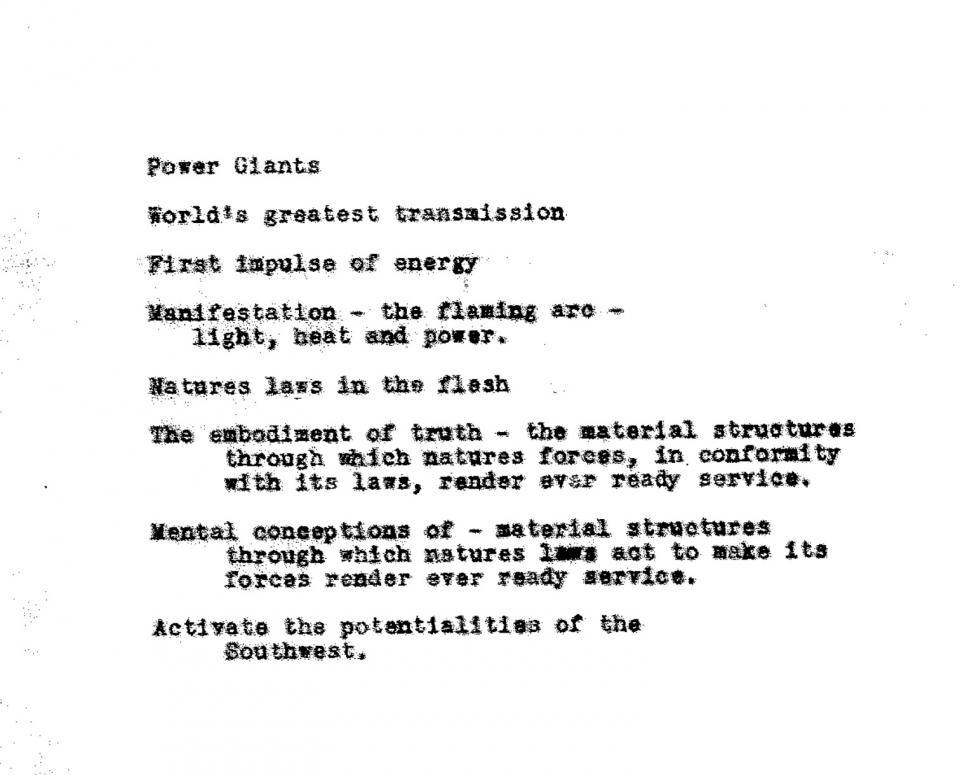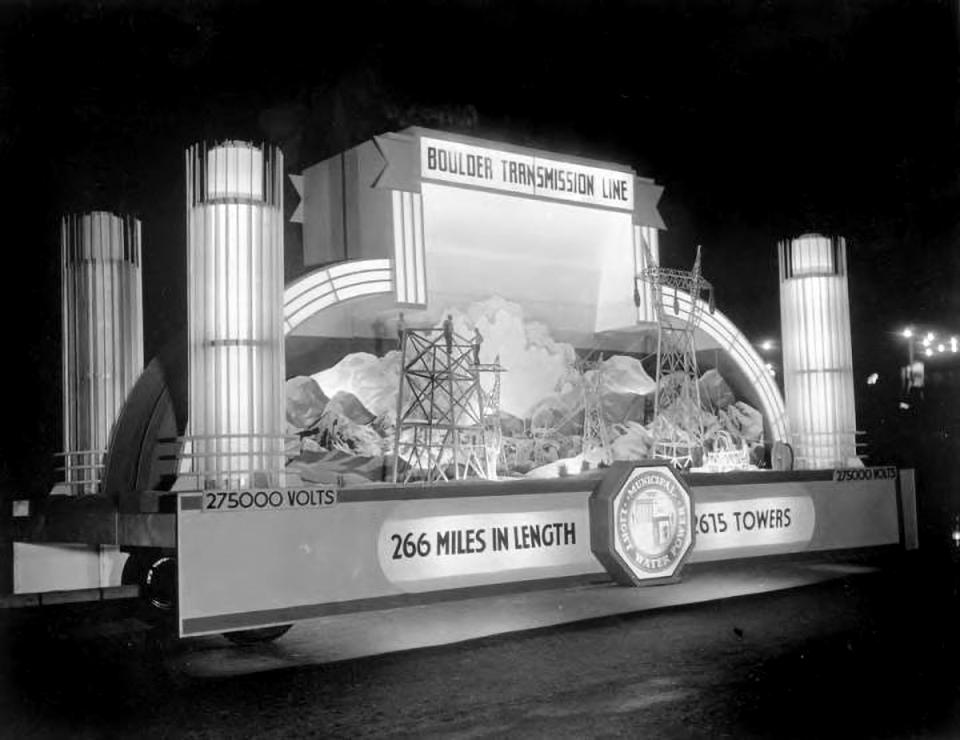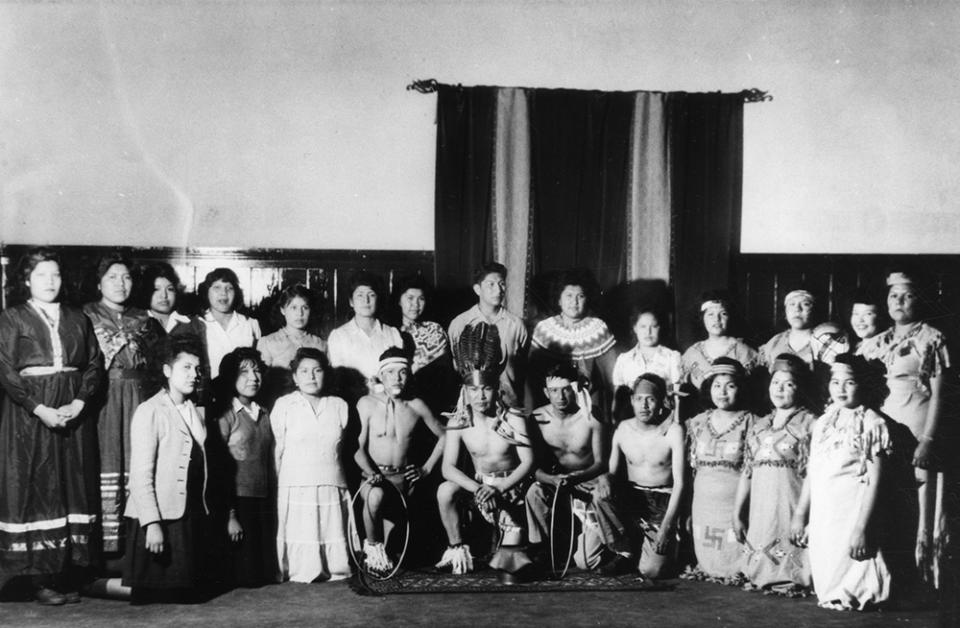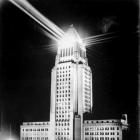On 9 October 1936, Elizabeth Scattergood ignited a 60-foot (18-meter) electric arc over the Los Angeles Civic Center with hydroelectricity from the just-completed Boulder (now Hoover) Dam. Introduced as “the American Girl who possesses the potentially most powerful fingertip the world has ever known,” 28-year-old Elizabeth stood before the crowd of one million observers largely due to the role her father, Ezra Frederick Scattergood, played in the dam’s construction. Her presence literalized Ezra Scattergood’s future reputation as “The Father of Modern Power” and marked the first in a series of ceremonial performances anchoring the dam in very traditional narratives about gender, race, and nature.

Elizabeth Scattergood, with her hand on the button, flanked by Frank Merriam, Governor of California, and her “maid of honor,” Louise Hepburn. On the right is John Haynes, chairman of the inaugural festivities committee.
Elizabeth Scattergood, with her hand on the button, flanked by Frank Merriam, Governor of California, and her “maid of honor,” Louise Hepburn. On the right is John Haynes, chairman of the inaugural festivities committee.
Courtesy the Los Angeles Times.
© Los Angeles Department of Water and Power
Used by permission
The copyright holder reserves, or holds for their own use, all the rights provided by copyright law, such as distribution, performance, and creation of derivative works.
Before pressing the button connecting Los Angeles and the Hoover Dam, Elizabeth Scattergood gave what the Los Angeles Times called “a simple little speech full of feeling” (see below). Her words personify the dam’s turbines as “Power Giants” in language referencing the Greek myth of Prometheus, who stole fire from the Gods and gifted it, along with civilization, to humanity. Scattergood highlighted the engineering accomplishment of the world’s longest transmission line, which would allow the American Southwest to fulfill its unnamed “potentialities.” Yet Scattergood quickly moved past the dam’s techno-scientific achievement to dwell on its poetic, even transcendent symbolism: its dual existence as a material and mental structure, and its role in mediating the “forces of nature” to serve human needs. Indeed, drafts of the speech may reveal a certain anxiety about the power of human technology to generate energy out of nothing but the chaotic, sometimes dangerous movement of water and emphasize that the process falls within the bounds of “natures laws” (sic).

Undated, uncredited notes on Scattergood’s speech in the archives of the Los Angeles Department of Water and Power.
Undated, uncredited notes on Scattergood’s speech in the archives of the Los Angeles Department of Water and Power.
© Los Angeles Department of Water and Power
Used by permission
The copyright holder reserves, or holds for their own use, all the rights provided by copyright law, such as distribution, performance, and creation of derivative works.
Scattergood’s ceremonial role resembled a woman christening a ship, and her speech offered a particularly White and feminine endorsement of an event staged with highly-gendered overtones. Picking up on the “Power Giants” metaphor, an account in the Los Angeles Times personifies electricity as a god-like and virile male figure with “meteor eyes flashing and lightning blazing around his head” whose entrance into the “dim-lit city” caused it to startle “like an aroused sleeper at his touch.” Electricity’s cultural life had been marked by such sensual and gendered associations for nearly two hundred years. For David Parisi, the Venus electrificada, a popular eighteenth-century demonstration, was a “site of spectacular gendered play” in which a suitor’s merit was demonstrated by his ability to withstand the shock administered through the charged lips of his beloved. Building on David Nye’s observations on the late-nineteenth-century rise of electric metaphors, Scott McQuire notes that “to feel electricity in the air became synonymous with excitement, arousal and even love.” In this context, the performative presence of Scattergood’s father and a friend identified in press photos in as her “maid of honor” offered a heterosexual, matrimonial frame—one understood as another of “natures laws.” For utilities whose business model rested on expanding home energy consumption through the mass adoption of modern conveniences, linking the domestication of power consumption to the White, heteropatriarchal family reinforced carefully crafted advertising narratives.

The lighting of Los Angeles City Hall at the Boulder Power Inaugural, 9 October 1936.
The lighting of Los Angeles City Hall at the Boulder Power Inaugural, 9 October 1936.
Courtesy of the Historical Photo Collection of the Department of Water and Power, City of Los Angeles.
© Los Angeles Department of Water and Power
Used by permission
The copyright holder reserves, or holds for their own use, all the rights provided by copyright law, such as distribution, performance, and creation of derivative works.
As the arc ignited by Scattergood’s “magic finger” was extinguished, LA’s iconic, art deco city hall was illuminated by a “billion candlepower” floodlight on the roof. In a moment underscoring what Nye describes as the particularly American conjunction of national exceptionalism and the technological sublime, floodlights from adjacent buildings powered on as a chorus sang the United States’ national anthem. Like in turn-of-the-century light shows, shifting floodlights highlighted distinctive architectural features, extending them immaterially into the night. McQuire has noted that such lighting effects produced dizzying illusions of mutability that reinforced the link between modernity and change, while Nye has noted that such spectacles celebrated the “conquest of nature” by defeating natural darkness.

A float in the “Lights On” parade celebrates the engineering accomplishment of the world’s longest transmission line.
A float in the “Lights On” parade celebrates the engineering accomplishment of the world’s longest transmission line.
Courtesy of the Historical Photo Collection of the Department of Water and Power, City of Los Angeles.
© Los Angeles Department of Water and Power
Used by permission
The copyright holder reserves, or holds for their own use, all the rights provided by copyright law, such as distribution, performance, and creation of derivative works.
Themes of conquest became literal in the next event of the evening, the “Lights On Parade.” Following a division of military bands, unnamed students from the nearby Sherman Institute, a residential school run by the Bureau of Indian Affairs, played roles in the “Prehistoric-Pioneer Days” pageant entitled “Aborigine Chief,” “Primitive Indians,” and “Indian Youths … Modern Trades.” Such residential schools were key to the government’s brutal policy of cultural annihilation, and the students’ public performance of “Indianness” to a largely White audience was framed by a heavy-handed “civilizing” narrative, beginning with the “primitive aborigine” and progressing through racially charged acts like “Cabrillo’s Ship,” “Peon Vendors,” and “Pioneers” before ending with the “Modern Trades,” implicitly powered by electricity from Hoover Dam. However, the Sherman students no doubt had their own reasons for participating. Their very presence was a reminder that the past they were purported to represent had never been fully extinguished and that there exist other ways of being modern than engineered Giants and powerful beams of pure, white light.

Native American student performers on stage at the Sherman Institute, Riverside, California, ca. 1940.
Native American student performers on stage at the Sherman Institute, Riverside, California, ca. 1940.
Courtesy of Shades of LA Collection, Los Angeles Public Library.
© Los Angeles Public Library.
Used by permission
The copyright holder reserves, or holds for their own use, all the rights provided by copyright law, such as distribution, performance, and creation of derivative works.
“Infrastructure,” Deborah Cowen claims, “almost by definition, reproduces relations, although sometimes in very queer ways.” However, she notes, it “is not only a vehicle of domination—it is also a means of transformation.” Although mediated by heavy-handed symbols reinforcing the eco-social relations of White, colonial modernity, the Boulder Power Inaugural nonetheless allowed the people of Los Angeles to experience their connection to the Colorado River and Hoover Dam. As climate change forces Los Angeles to rework these infrastructures, the cultural mythologies and social relations they sustained must also be reimagined. What forms of ritual and collective assembly might make palpable an alternative intimacy with the “forces of nature” on which all energy—and all life—depends?
How to cite
Kanouse, Sarah. “Touching Power: White Womanhood, Colonial Spectacle, and the ‘Forces of Nature’ at the Boulder Power Inaugural.” Environment & Society Portal, Arcadia (Summer 2021), no. 34. Rachel Carson Center for Environment and Society. doi:10.5282/rcc/9369.
ISSN 2199-3408
Environment & Society Portal, Arcadia
 This work is licensed under a Creative Commons Attribution 4.0 International License.
This work is licensed under a Creative Commons Attribution 4.0 International License.
2021 Sarah Kanouse
This refers only to the text and does not include any image rights.
Please click on the images to view their individual rights status.
- Bakke, Gretchen. The Grid: The Fraying Wires Between Americans and Our Energy Future. New York: Bloomsbury, 2016.
- Cowen, Deborah. “Following the Infrastructures of Empire: Notes on Cities, Settler Colonialism, and Method.” Urban Geography 41, no. 4 (2019): 469–86.
- McQuire, Scott. “Electropolis.” In The Media City: Media, Architecture, and Urban Space, 113–129. London: Sage, 2008.
- Needham, Andrew. Power Lines: Phoenix and the Making of the Modern Southwest. Princeton, NJ: Princeton University Press, 2014.
- Nye, David E. Electrifying America: Social Meanings of a New Technology, 1880–1940. Cambridge, Mass.: MIT Press, 1990.
- Nye, David E. American Illuminations: Urban Lighting, 1800–1920. Cambridge, Mass.: MIT Press, 2018.
- Parisi, David. “The Electrotactile Machine.” In Archaeologies of Touch: Interfacing with Haptics from Electricity to Computers. Minneapolis: University of Minnesota Press, 2018.








